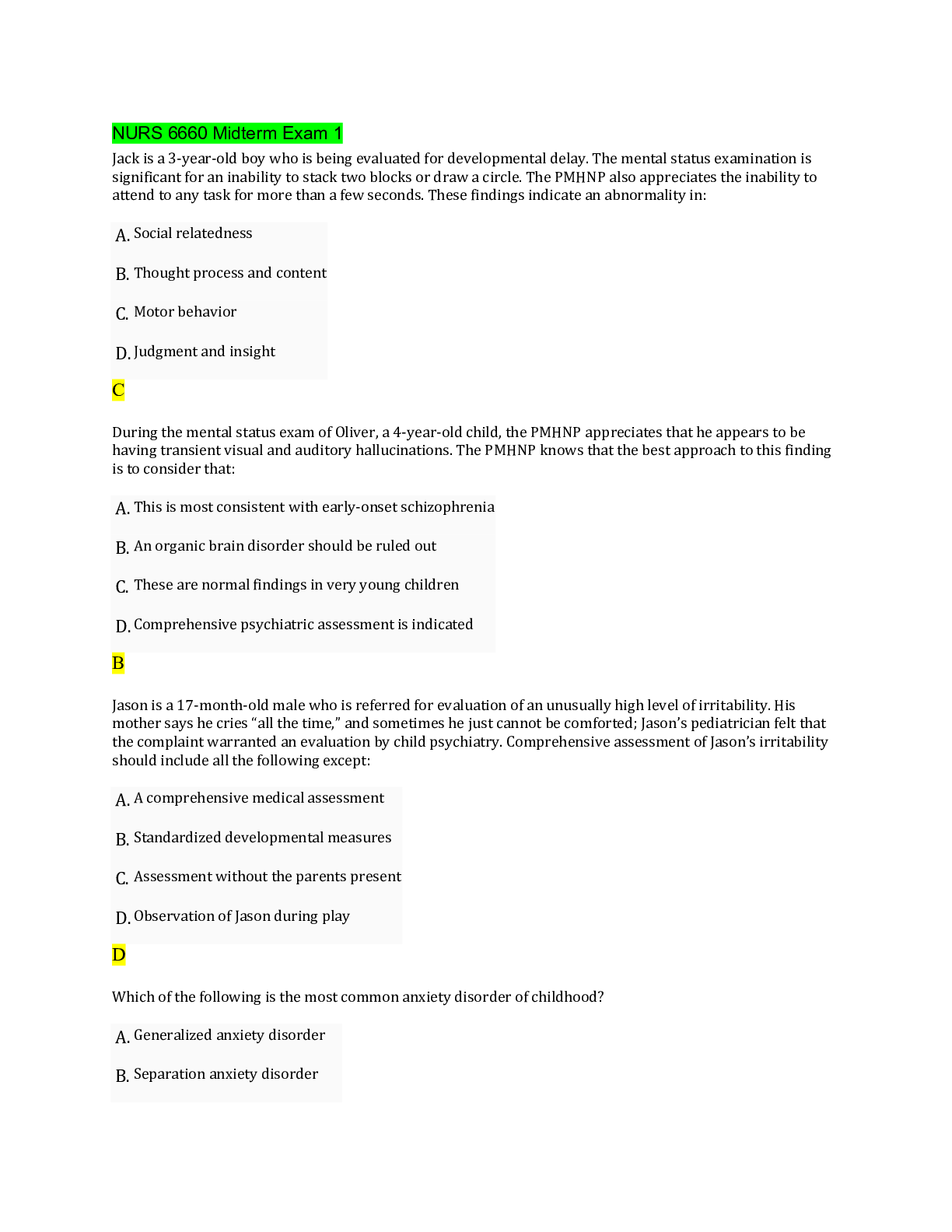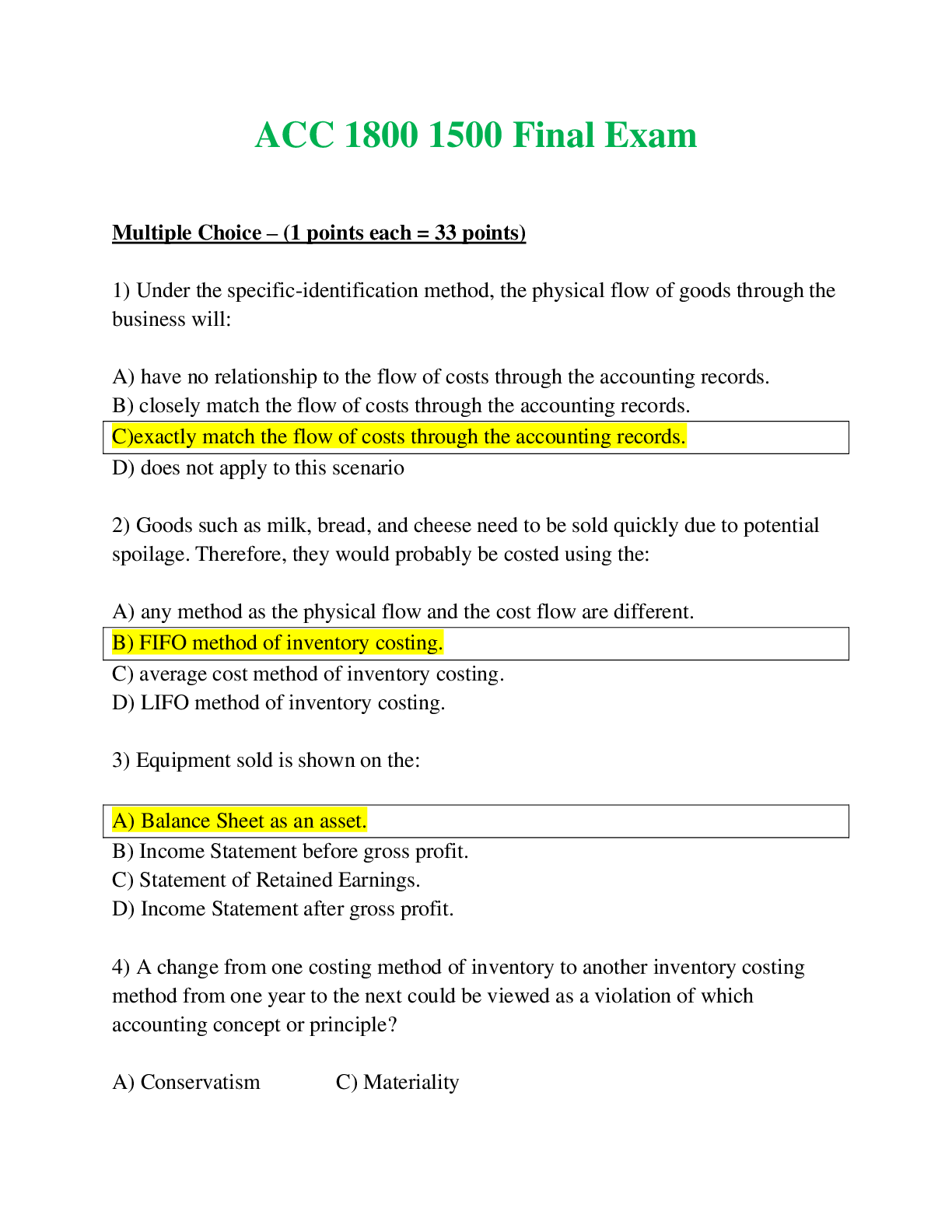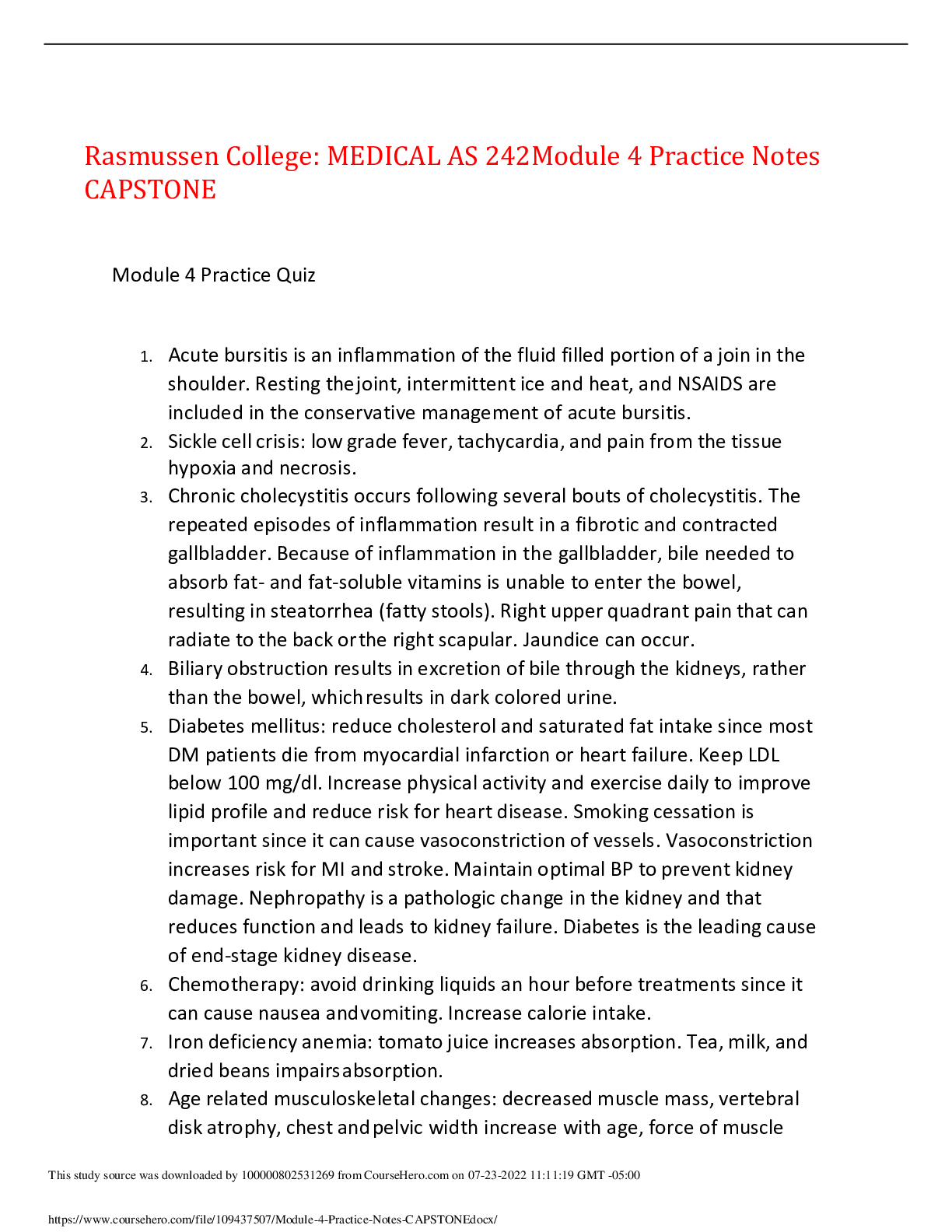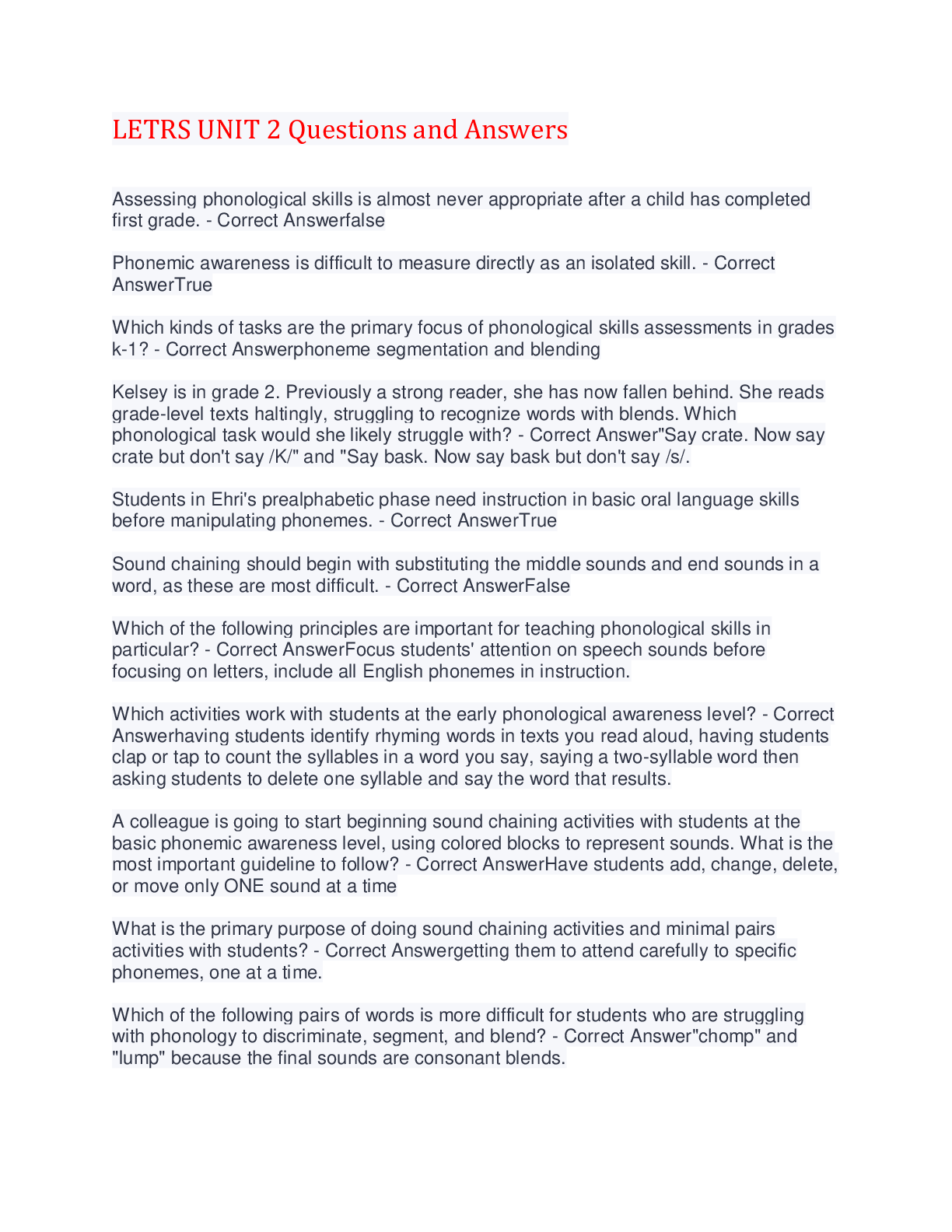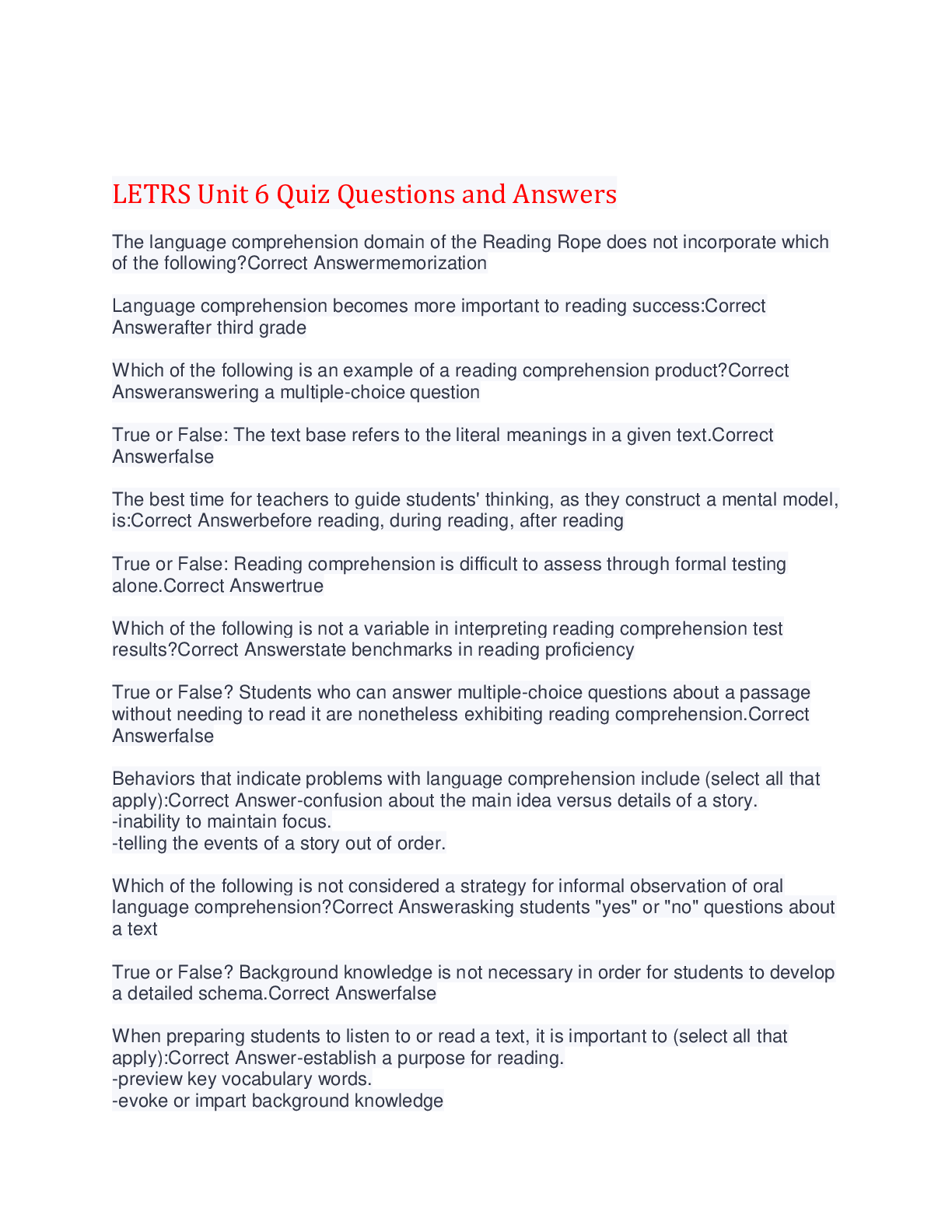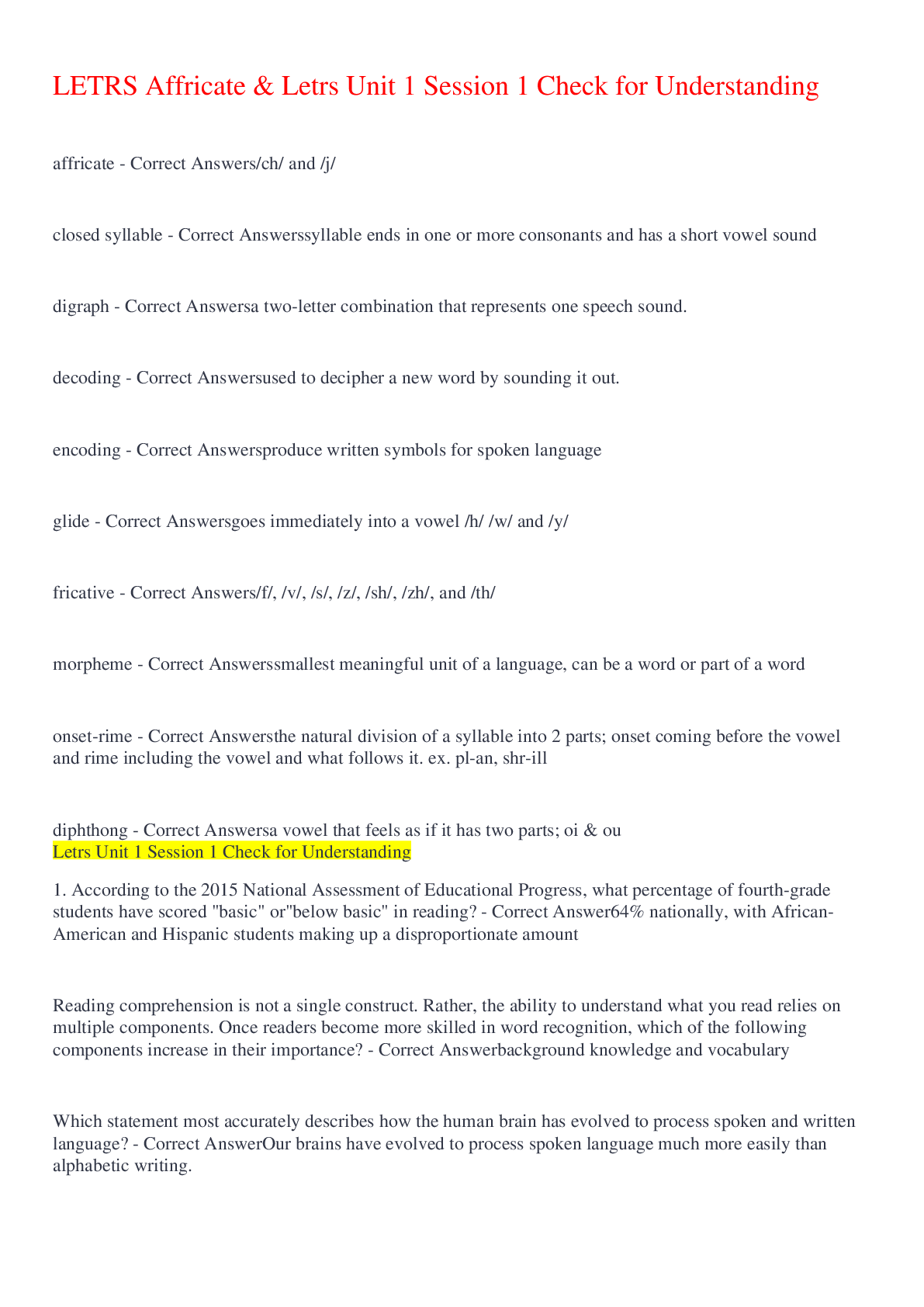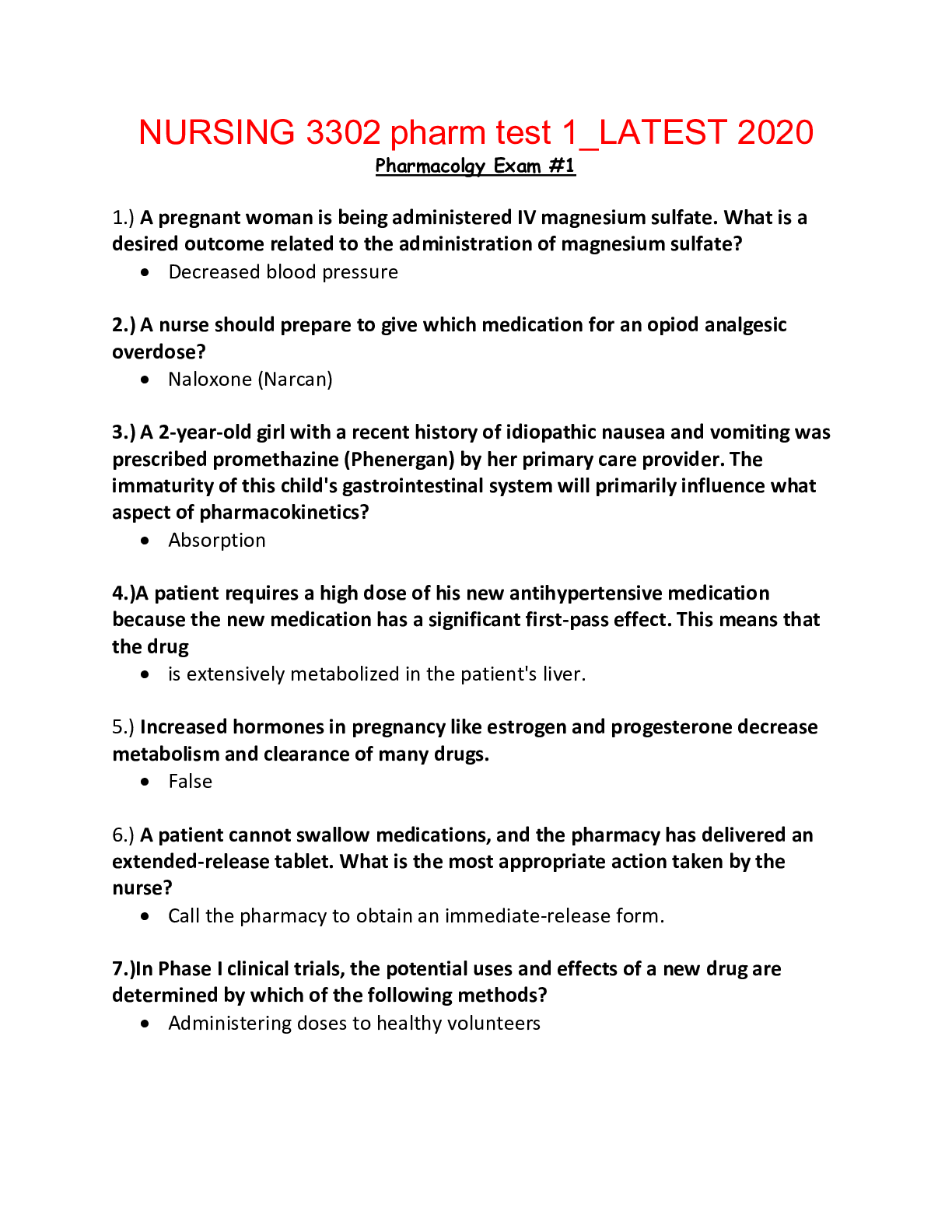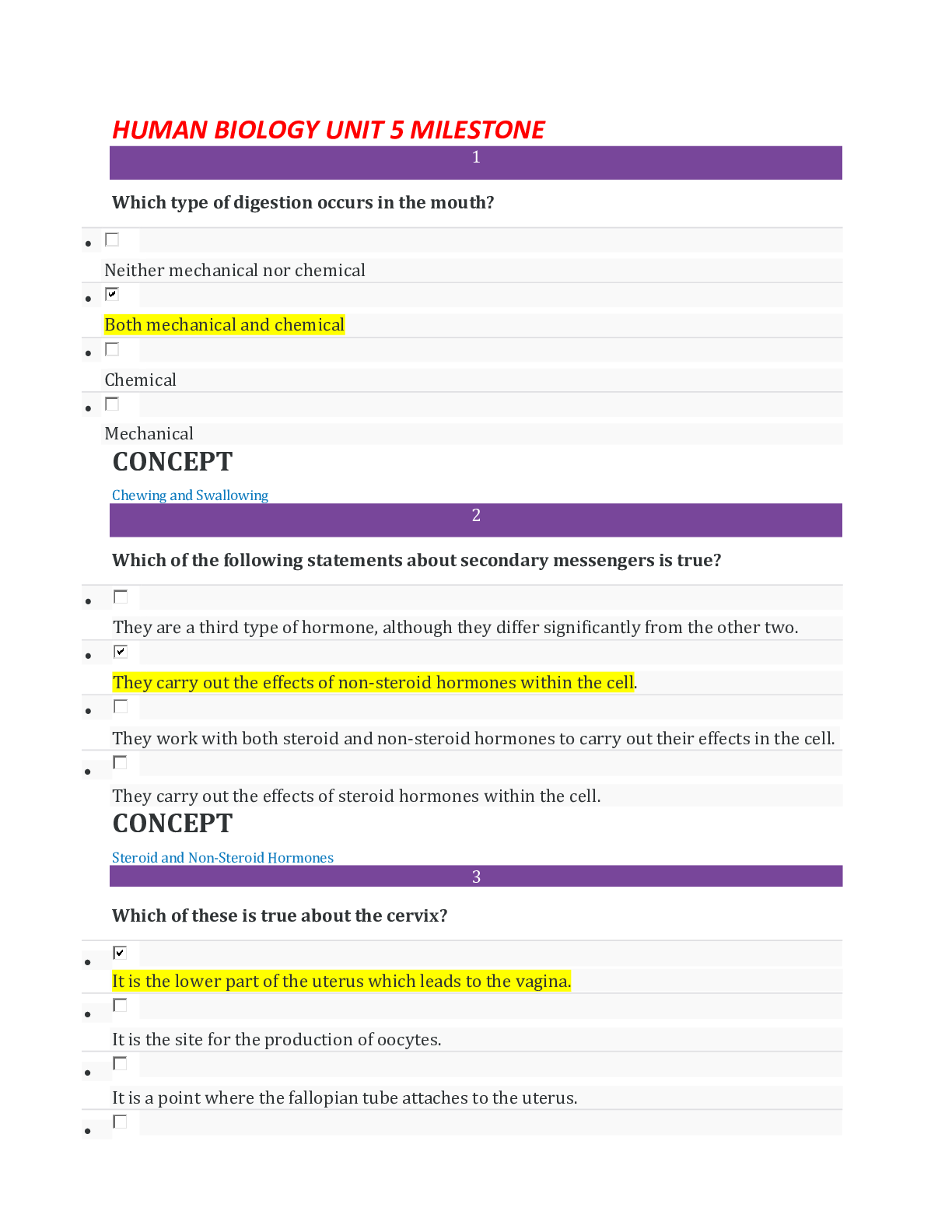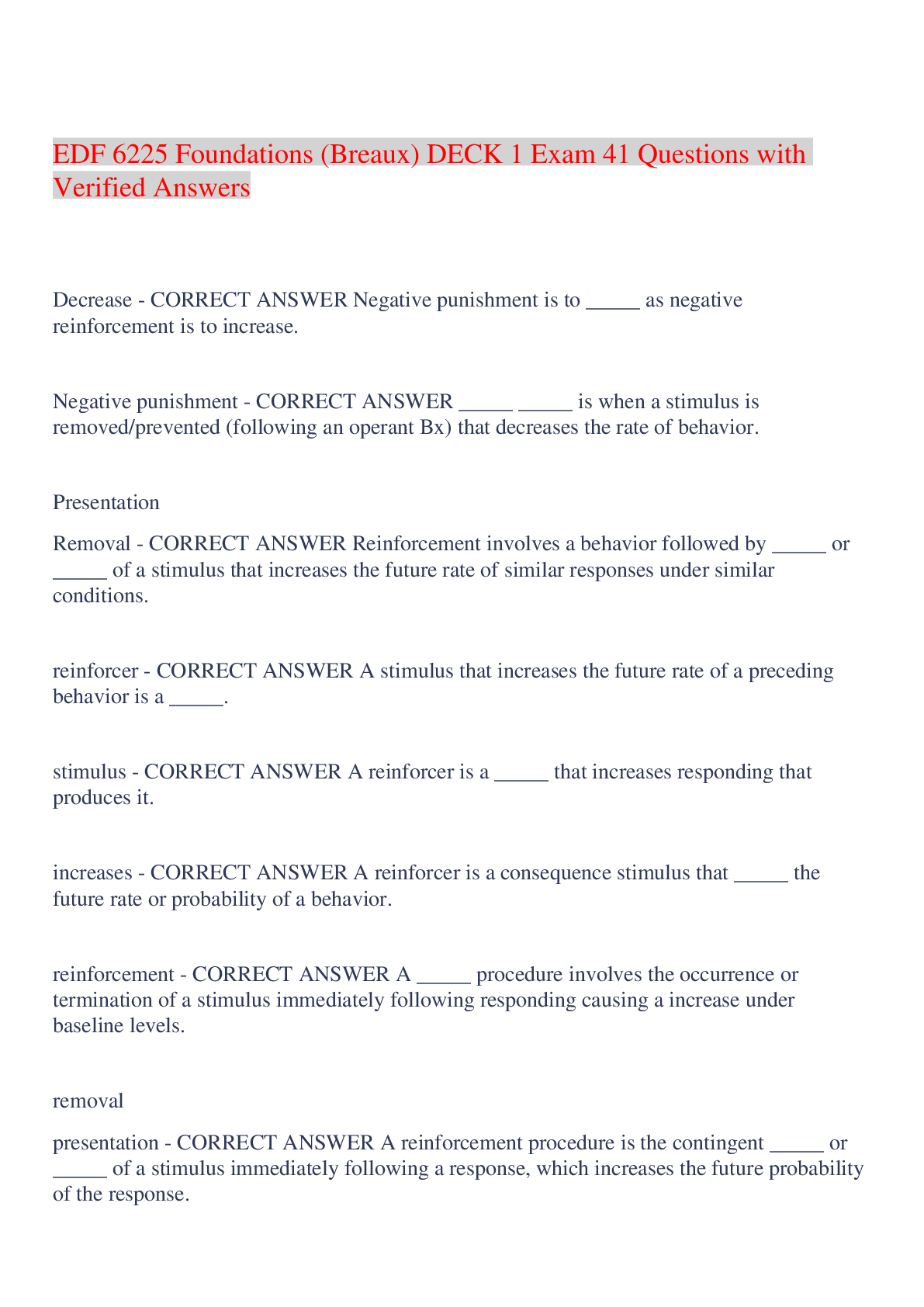Eco 102 Exam I,100% CORRECT
Document Content and Description Below
1. With respect to the consumer price index, the substitution bias arises because (a) prices of goods and services do not change in the same proportion from year to year. (b) consumers are slow to ... adjust their buying patterns from year to year in response to price changes. (c) consumers are eager to buy new products as they are introduced, despite their lack of full infor- mation about the quality of those products until they buy and use them. (d) All of the above are correct. 2. If the real interest rate is 10.3% and the inflation rate is 2.3%, what is the nominal interest rate? (a) 8% (b) 12.3% (c) 7% (d) 12.6% Table 1: Assume that the typical consumer buys 25 pounds of meat and 15 pounds of potatoes each month, and that January is the base period. Month Price of Meat Price of Potatoes January 3.50 1.50 February 3.38 0.60 March 4.00 1.40 3. Refer to Table 1: Calculate the cost of a basket of goods for February: (a) 110 (b) 100 (c) 93.50 (d) 121 4. Refer to Table 1: Calculate the Consumer Price Index (CPI) for March: (a) 110 (b) 100 (c) 93.50 (d) 85 5. Refer to Table 1: Calculate the inflation rate for March: (a) 11% (b) 29.4% (c) 15% (d) -15% 6. If the CPI was 108.00 in 1942 and is 336.96 today, then $10 in 1942 purchased the same amount of goods and services as: (a) $2.57 purchases today. (b) $28.89 purchases today. (c) $31.20 purchases today. (d) $38.89 purchases today. 7. In 1931 the price of a movie ticket was $0.25. The consumer price index was 15.2 in 1931, and 210 in 2008. Using 2008 prices, the real price of a movie in 1931 was: (a) $13.82 (b) $52.20 (c) $1.81 (d) $3.45 8. Suppose that over the past year, the real interest rate was 6 percent and the inflation rate was 4 percent. It follows that (a) the dollar value of savings increased at 6 percent, and the purchasing power of savings increased at 2 percent. (b) the dollar value of savings increased at 6 percent, and the purchasing power of savings increased at 10 percent. (c) the dollar value of savings increased at 10 percent, and the purchasing power of savings increased at 2 percent. (d) the dollar value of savings increased at 10 percent, and the purchasing power of savings increased at 6 percent. 9. When constructing the consumer price index, the Bureau of Labor Statistics does not do which of the following? (a) Try to include all the goods and services that the typical consumer buys. (b) Try to weight the goods and services that the typical consumer buys according to how much consumers buy of each item. (c) Survey consumers to determine what the typical consumer buys. (d) Survey sellers to determine what the typical consumer buys. 10. When Netflix recently increased monthly service fees from 10.00 to 16.00, they lost 600,000 customers. This is an example of: (a) a reduction in supply. (b) the law of supply. (c) a reduction in demand. (d) the law of demand. 11. If the demand for digital cameras increases when consumers’ incomes rise, then digital cameras are (a) a normal good. (b) an inferior good. (c) a substitute for camcorders. (d) a complement to camcorders. Figure 1: Production Possibilities Frontier 12. Refer to Figure 1. Which point is both Attainable and Inefficient? (a) Point A (b) Point B (c) Point C (d) Point D 13. Refer to Figure 1. Points A and B are: (a) Inefficient (b) Attainable and inefficient (c) Attainable and efficient (d) Unattainable and inefficient (e) Unattainable 14. If ramen noodles are an inferior good, then an increase in income results in: (a) an increase in the demand for ramen noodles. (b) a decrease in the demand for ramen noodles. (c) an increase in the supply of ramen noodles. (d) a decrease in the supply of ramen noodles. 15. A farmer produces oranges and sells them to Fresh Juice, which makes orange juice. The oranges produced by the farmer are called (a) inventory goods (b) transitory goods (c) final goods (d) intermediate goods 16. A farmer produces oranges and sells them to Fresh Juice, which makes orange juice. The orange juice sold by Fresh Juice is considered (a) an inventory good (b) a transitory good (c) a final goods (d) an intermediate goods Figure 2: Supply and Demand 17. Refer to Figure 2. Panel (c) shows which of the following? (a) an increase in demand and an increase in quantity supplied (b) an increase in demand and an increase in supply (c) an increase in quantity demanded and an increase in quantity supplied (d) an increase in quantity demanded and an increase in supply 18. Refer to Figure 2. Panel (b) shows which of the following? (a) a decrease in demand and a decrease in quantity supplied (b) a decrease in demand and a decrease in supply (c) a decrease in quantity demanded and a decrease in quantity supplied (d) a decrease in quantity demanded and a decrease in supply 19. Refer to Figure 2. Which of the four panels represents the market for peanut butter after a major hurricane hits the peanut-growing south? (a) Panel (a) (b) Panel (b) (c) Panel (c) (d) Panel (d) Table 2: Year Price of Rice Qty. of Rice Price of Beans Qty. of Beans 2013 3.50 20 1.5 10 2014 3.50 40 2.5 15 2015 4.00 40 3.5 30 2016 4.50 80 5.0 40 20. Refer to Table 2. What is nominal GDP in 2015? (a) $85 (b) $177.50 (c) $95 (d) $265 21. Refer to Table 2. In 2015, this country’s: (a) real GDP was $185, and the GDP deflator was 143.2. (b) real GDP was $185, and the GDP deflator was 109.23. (c) real GDP was $265, and the GDP deflator was 143.2. (d) real GDP was $265, and the GDP deflator was 109.23. 22. Refer to Table 2. In 2016, this country’s: (a) real GDP was $560, and the GDP deflator was 143.2. (b) real GDP was $560, and the GDP deflator was 164.7. (c) real GDP was $340, and the GDP deflator was 164.7. (d) real GDP was $340, and the GDP deflator was 109.23. 23. Refer to Table 2. In 2016, this country’s inflation rate is: (a) 9.2% (b) 31.1% (c) 13.2% (d) 15.0% 24. A country’s real GDP rose from $1200 to $1500 while its nominal GDP rose from $1500 to $2250. What was this country’s inflation rate? (a) 10.5% (b) 8.1% (c) 20.0% (d) 15.0% 25. Because every transaction has a buyer and a seller, (a) GDP is more closely associated with an economy’s income than it is with an economy’s expendi- ture. (b) every transaction contributes equally to an economy’s income and to its expenditure. (c) the number of firms must be equal to the number of households in a simple circular-flow diagram. (d) firms’ profits are necessarily zero in a simple circular-flow diagram. 26. If net exports is a negative number for a particular year, then (a) the value of firms’ inventories declined over the course of the year. (b) consumption exceeded the sum of investment and government purchases during the year. (c) the value of goods sold to foreigners exceeded the value of foreign goods purchased during the year. (d) the value of foreign goods purchased exceeded the value of goods sold to foreigners during the year. 27. If real GDP is $3500 billion, the GDP deflator is 120, real net exports are $300 billion, real investment is $400 billion, and real government expenditures are $700 billion, what is real consumption? (a) $2300 (b) $2500 (c) $2800 (d) $2100 28. If nominal GDP is $3500 billion, the GDP deflator is 175, real net exports are $150 billion, real consumption is $800 billion, and real government expenditures are $400 billion, what is real investment? (a) $650 (b) $2150 (c) $750 (d) $2500 29. Phoenix furniture uses 12 workers, each working eight hours, to produce 192 rocking chairs. What is Phoenix’s productivity? (a) 192 rocking chairs (b) 24 rocking chairs per hour (c) 2 hours per rocking chair (d) 2 rocking chairs per hour 30. In 2011, Modern Electronics, Inc. produced 64,000 calculators, employing 10 workers, each of whom worked 8 hours per day. In 2012, the same firm produced 80,000 calculators, employing 12.5 workers, each of whom worked 8 hours per day. Productivity at Modern Electronics (a) increased by 16,000 (b) remained constant (c) increased by 2 units per hour (d) decreased by 2 units per hour 31. The fact that borrowers sometimes default on their loans by declaring bankruptcy is directly related to the characteristic of a bond called (a) credit risk (b) interest risk (c) term risk (d) maturity risk 32. Which of the following is both a financial institution and a financial intermediary? (a) banks (b) stock exchanges (c) the bond market (d) all of the above are correct. 33. Which of the following is both a financial institution and a financial market? (a) banks (b) stock exchanges (c) mutual funds (d) all of the above are correct. Figure 3: Market for Loanable Funds 34. Refer to Figure 3. What, specifically, does the label on the vertical axis, r, represent? (a) the nominal interest rate. (b) the real interest rate. (c) inflationary expectations. (d) the dividend yield 35. Refer to Figure 3. Which of the following events could explain a shift of the demand-for-loanable- funds curve from D1 to D2? (a) The tax code is reformed to encourage greater saving. (b) The tax code is reformed to encourage greater investment. (c) The government starts running a budget deficit. (d) The government starts running a budget surplus. 36. Refer to Figure 3. Which of the following events could explain a shift of the supply-for-loanable-funds curve from S1 to S2? (a) The tax code is reformed to encourage greater saving. (b) The tax code is reformed to encourage greater investment. (c) The government starts running a budget deficit. (d) The government starts running a budget surplus. 37. Other things the same, a government budget deficit (a) reduces public saving, but not national saving. (b) reduces national saving, but not public saving. (c) reduces both public and national saving. (d) reduces neither public saving nor national saving. 38. In the small closed economy of San Lorena, the currency is the dollar. Statistics for last year show that private saving was 60 billion dollars, taxes were 80 billion dollars, government purchases of goods and services were 70 billion dollars, there were no transfer payments by the government, and GDP was 400 billion dollars. What were consumption and investment in San Lorena? (a) 270 billion dollars, 50 billion dollars (b) 250 billion dollars, 60 billion dollars (c) 250 billion dollars, 60 billion dollars (d) 260 billion dollars, 70 billion dollars (e) None of the above. 39. Suppose a closed economy had public saving of -$1 trillion and private saving of $3 trillion. What are national saving and investment for this country? (a) $2 trillion, $2 trillion (b) $2 trillion, $3 trillion (c) $3 trillion, $3 trillion (d) $4 trillion, $2 trillion 40. When public saving falls by $2b and private saving falls by $1b in a closed economy, (a) investment falls by $1b. (b) investment falls by $3b. (c) investment increases by $1b. (d) investment falls by $2b. 41. Bonus Question If you choose an answer to this question at random, what is the chance you will be correct? (a) 25% (b) 50% (c) 60% (d) 25% [Show More]
Last updated: 2 years ago
Preview 1 out of 8 pages

Buy this document to get the full access instantly
Instant Download Access after purchase
Buy NowInstant download
We Accept:

Reviews( 0 )
$15.00
Can't find what you want? Try our AI powered Search
Document information
Connected school, study & course
About the document
Uploaded On
Nov 05, 2020
Number of pages
8
Written in
Additional information
This document has been written for:
Uploaded
Nov 05, 2020
Downloads
0
Views
62


